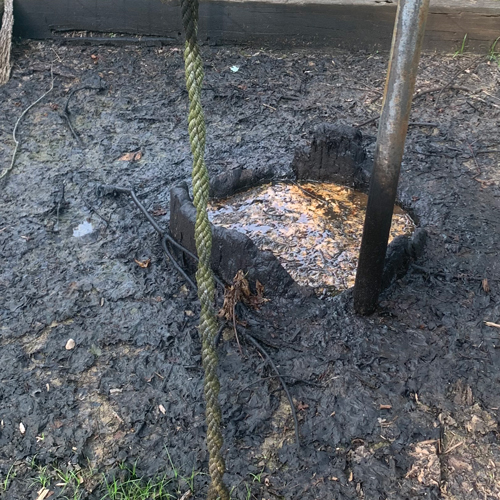Pittsburgh, PA Lewis waits for the barge to be finished so that he can head down the Ohio River. Here, Seneca oil is described by Thaddeus Harris during his 1803 visit.
Thorla-McKee Well
By Wikimedia Commons user Raderwv who has published using the Creative Commons Attribution-Share Alike 4.0 International license, commons.wikimedia.org/wiki/File:Thorla-McKee_Well.jpg.
Seneca Oil
The Seneca Indian Oil in so much repute here is Petroleum; a liquid bitumen, which oozes through fissures of the rocks and coal in the mountains, and is found floating on the surface of the waters of several springs in this part of the country, whence it is skimmed off, and kept for use. From a strong vapour which arises from it when first collected, it appears to combine with it sulphureous particles. It is very inflammable. In these parts it is used as a medicine; and, probably, in external applications with considerable success. For chilblains and rheumatism it is considered as an infallible specific. I suppose it to be the bitumen which Pliny describes under the name of Naptha, Lib. II. ch. 105.
—Thaddeus Harris[1]Thaddeus Harris, The Journal of a Tour into the Territory Northwest of the Alleghany Mountains Made in the Spring of the Year 1803, p. 46 in Reuben G. Thwaites, Travels West of the Alleghanies … Continue reading
Thorla-McKee Well
The Thorla-McKee well was an early petroleum well in Noble County, Ohio predating oil wells drilled specifically for refining oil. A historical marker reads:
Salt was an important commodity to early settlers because of its use in daily living. In 1814 Silas Thorla and Robert McKee dug a well in search of salt brine. They discovered salt, and by accident, discovered oil. Oil’s value was unknown to them so they had to separate the oil from the salt water by soaking the oil up from the surface with blankets. The oil was wrung from the blankets, bottled as “Seneca Oil,” and sold as a “cure all.” The remaining brine was boiled down to extract the salt.
After the Thorla-McKee well, other wells drilled for salt brine in Kentucky and West Virginia also produced oil and gas as byproducts. The Drake Well, drilled in Pennsylvania in 1859, is generally recognized as the first well in the United States drilled for oil itself.”[2]“Thorla-McKee Well,” Wikipedia, en.wikipedia.org/wiki/Thorla-McKee_Well accessed 23 November 2022.
Native American Uses
According to chemical engineer Alfred N. Mann, the Seneca tribe of the Iroquois Nation, collected seep oil centuries before European settlers did and that “they” used the oil as salve, mosquito repellent, purge and tonic, as well as wigwam waterproofing, body paint, and for various religious practices.” European settlers also used the oil for medicinal purposes and as a lubricant. Mann reports that the natural seeps produced “a few gallons per day.”[3]Alfred N. Mann, “Some Petroleum Pioneers of Pittsburgh” Heinz History Center, www.heinzhistorycenter.org/wp-content/uploads/2022/08/4-Petroleum-Pioneers.pdf accessed 22 November 2022.
We do not know if Lewis picked up some Seneca oil while was in Pittsburgh. It is not mentioned in any known journals, receipts, and correspondence.
Notes
| ↑1 | Thaddeus Harris, The Journal of a Tour into the Territory Northwest of the Alleghany Mountains Made in the Spring of the Year 1803, p. 46 in Reuben G. Thwaites, Travels West of the Alleghanies (Cleveland: The Arthur H. Clark Co., 1904), p. 346. |
|---|---|
| ↑2 | “Thorla-McKee Well,” Wikipedia, en.wikipedia.org/wiki/Thorla-McKee_Well accessed 23 November 2022. |
| ↑3 | Alfred N. Mann, “Some Petroleum Pioneers of Pittsburgh” Heinz History Center, www.heinzhistorycenter.org/wp-content/uploads/2022/08/4-Petroleum-Pioneers.pdf accessed 22 November 2022. |

